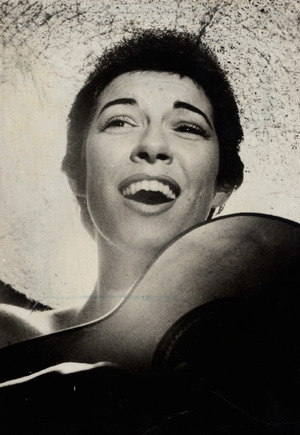Inezita Barroso facts for kids
Quick facts for kids
Inezita Barroso
|
|
|---|---|

Barroso in 1956
|
|
| Background information | |
| Birth name | Ignez Magdalena Aranha de Lima |
| Born | March 4, 1925 São Paulo, Brazil |
| Died | March 8, 2015 (aged 90) São Paulo, Brazil |
| Genres | Sertanejo |
| Occupation(s) | Singer, guitarist, actor, librarian, folklorist, teacher |
| Instruments | Vocals, viola caipira |
| Years active | 1951–2015 |
Inezita Barroso (born Ignez Magdalena Aranha de Lima; March 4, 1925 – March 8, 2015) was a famous Brazilian singer, guitarist, and actress. She was also a TV presenter, librarian, folklorist, and teacher. She was best known for her sertanejo music, which is a type of Brazilian country music.
Contents
About Inezita Barroso
Inezita Barroso was born in São Paulo, Brazil, on March 4, 1925. She loved music from a young age. She started singing when she was seven years old. By age eleven, she began to study piano.
Even though she grew up in the city, Inezita had a deep love for country music. She spent weekends and holidays in the countryside with relatives. This helped her develop a passion for country music. However, it was not easy. At that time, it was unusual for women to sing and play the viola (a type of guitar). Her family was not happy about her musical dreams. Inezita also studied to become a librarian because she truly loved books.
Early Career and First Recordings
In the 1940s, Inezita married and began her music career. She sang folk songs that a famous poet, Mário de Andrade, had collected. She started singing on Rádio Clube do Recife. Her stage name, Inezita Barroso, came from her first name and her husband's last name.
She first appeared as an actress in a film called "Ângela" in 1950. In the same year, she started working on Rádio Bandeirantes in São Paulo. In 1951, she moved to Radio Record. There, she hosted a show called "Vamos Falar de Brasil" in 1954.
Inezita recorded her first album in 1951. She sang songs like "Funeral de um Rei Nagô" and "Curupira." In 1953, she recorded two of her biggest hits: "Marvada Pinga" and "Ronda." These songs became very popular.
Awards and Films
Inezita Barroso also acted in several films. In 1953, she was in "Destino em Apuros" and "Mulher de Verdade." For "Mulher de Verdade," she won the Saci Award for best actress.
In 1954, she started hosting weekly folklore programs on TV Record. She won the Roquette Pinto Award for best Brazilian popular radio singer. She also received the Guarani Award for best record singer. She continued acting in films like "É Proibido Beijar" and "O Craque."
In 1955, Inezita recorded more songs. She also acted in "Carnaval em Lá Maior," a film that represented Brazil at a festival in Uruguay. That year, she won more awards, including another Saci Award for best actress and a Roquette Pinto Award for best singer.
Later Years and Legacy
Inezita Barroso continued to record many successful songs. In 1958, she recorded "Lampião de Gás," which became another huge hit. She also recorded "Fiz a Cama na Varanda" and "Moda do Bonde Camarão."
In the 1970s, she traveled a lot to research music. She performed concerts across Brazil. She also recorded special programs for countries like the Soviet Union, Israel, and the United States. In 1970, she made a documentary about Brazil for an exhibition in Japan.
From 1980 onwards, Inezita hosted the popular TV show "Viola Minha Viola" on TV Cultura. She presented this show for over 34 years! It became a very important program for Brazilian country music. In 1985, a samba school honored her life and work during Carnival.
Inezita Barroso was known as "The Queen of Folklore." She was seen as a symbol of true Brazilian country music. She recorded more than 60 albums throughout her amazing career. Her last work, "Sonho de Caboclo," was released in 2009. In 2013, she released her first DVD. Several books have been written about her life and career.
Inezita Barroso passed away in São Paulo on March 8, 2015, at the age of 90. She left behind a rich legacy in Brazilian music and culture.
Personal Life
Inezita Barroso was married to Adolfo Cabral Barroso from 1947 until he passed away in 2006. They had one child together.
Discography Highlights
Inezita Barroso released many albums during her career. Some of her notable studio albums include:
- 1955 – Lá Vem o Brasil
- 1958 – Vamos Falar de Brasil
- 1962 – Clássicos da Música Caipira
- 1975 – Inezita Barroso em Todos os Cantos
- 1996 – Voz e Viola (with Roberto Corrêa)
- 1997 – Caipira de Fato (with Roberto Corrêa)
- 2009 – Sonho de Caboclo
She also released several compilation albums, which are collections of her best songs.
Filmography Highlights
Inezita Barroso acted in nine feature films. Some of them are:
- 1950 – Ângela
- 1953 – Mulher de Verdade
- 1954 – O Craque
- 1955 – Carnaval em Lá Maior
- 1970 – Isto é São Paulo
She also released several DVDs featuring her performances and life story.
See also
 In Spanish: Inezita Barroso para niños
In Spanish: Inezita Barroso para niños
- Viola caipira
- Braz da Viola

